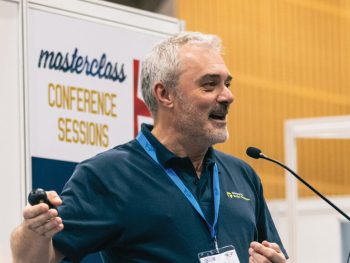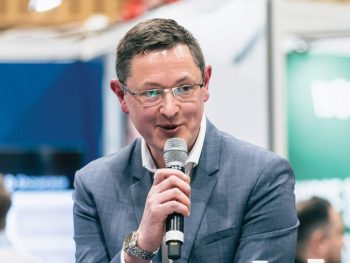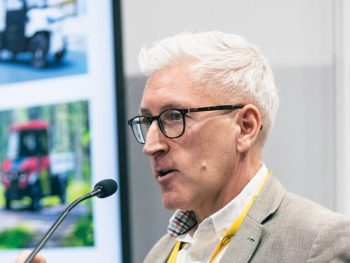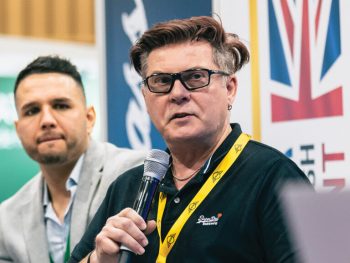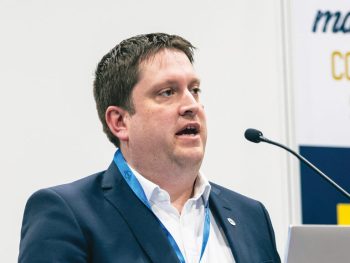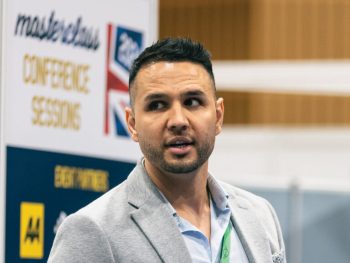A class act: Insights from the 2024 Great British Fleet Event Masterclasses
The great and the good of the fleet industry were happy to impart their wisdom to the Great British Fleet Event audience, with a lot of ground covered. By John Challen.
Kicking off the day’s proceedings in the fleet management session was Simon Turner, campaign manager at Driving for Better Business, which was debuting its driving for work policy builder at the show.
Turner went into detail about risk-related numbers associated with different industries, pointing out that the number of fatalities for those driving for work were much higher than average. As a sidenote, he highlighted the cost to UK Plc of these incidents (£2.6bn a year) and stated that the odds of being involved in an injury or collision while driving for work was one in 500.
To help try and improve the situation, Turner outlined what is required in a driving for work policy that would be effective for fleets and detailed the advantages of Driving for Better Business’ own policy and how audience members could make it work for them.
Turner then handed over to Thomas Caldwell, then global CTO of Techniche, which is involved in the world of cybersecurity, counting a number of major fleet companies – such as Shell and BP – among its client base. He explained that previously, the industry had been subjected to almost isolated attacks on vehicles, but now the issue is much more widespread.
To understand the problem, he reasoned, people needed to understand the automotive ecosystem, because “there is a lot of data floating around in the ether that needs protecting”.
He explained how his company specialised in asset management as well as the requirement for total system integration in order to carry out maintenance and software upgrades on chargers. As 95% of attacks or incidents are remote, he said hackers get into systems through the “back door” to mess with the setting, even impersonating existing staff in order to gain access to the network.
The final speaker of the fleet management session was Amanda Welland, partner account manager at Geotab. Welland was present to try and unveil the electrification realities of more than 1.3 million vehicles on the road – and suggest how the likes of Geotab could help improve fleet performance and efficiency. She explained the company’s EV suitability assessment, which had included those 1.3 million vehicles across a total of eight countries. The results made for interesting reading and showed that, on average, each light duty vehicle drove fewer than 80 miles a day. Furthermore, evidence suggested that 41% of the vehicles that were monitored could switch to electrified models in order to improve total cost of ownership within a fleet.
“In the UK, the average car drives 58 miles a day and 49% have never done more than 250 miles in a single day,” she told the audience. “Therefore, electrification has the potential to save fleets thousands of pounds.”
GRID TALK
First up in the electric vehicles session was Maria Bengtsson, the UK and Ireland electric vehicle lead at EY UK. She looked at fleet electrification from an energy point of view and the process of procuring energy, as opposed to diesel and petrol. She acknowledged there were differences between the two, such as the ability to store power in the same way as fuel as well as the logistics when it comes to purchasing. Wholesale power prices since 2019 were also discussed, Bengtsson acknowledging that as the main cost faced in the procurement process. “There has been a lot of volatility since 2019 and no-one could have forecast what happened, which made setting power prices much more difficult,” she reasoned.
She covered the different ways of approaching the market, modelling the levelled cost of electricity. The results, said Bengtsson, showed that only investing in energy storage does not improve a business – other steps need to be considered and taken.
Next up was returning speaker Dan Lawrence-Eyre, the co-founder and COO of Diode. He spoke about how fleet managed could make a more informed decision, based around a set of 21 questions that Diode advised asking when considering the transition to electric.
“The first questions are ‘What is the EV readiness of my fleet?’ and ‘What’s the interest in EVs with my employees?”, explained Lawrence-Eyre. Further questions were based around workplace charging – particularly how many points should be installed. The danger, warned Lawrence-Eyre, was not planning for the future or understanding what is going to futureproof the business, which could cause mistakes being made in the mid and long run. “Questions around savings also need to be asked – both in terms of money, but also fleet emissions,” he stated.
Within the 21 questions are a set tailored to individual drivers, because each one is different and the vehicle they are driving could change on an almost daily basis.
For a different perspective on proceedings, the final speaker in the session was Tommi Salminen, vehicle policy advisor at the Department for Transport’s Office for Zero Emission Vehicles (OZEV).
“The aims of OZEV are tackle emissions, improve air quality and help people transition to EVs,” he explained. “For example, the Government has spent more than £2bn in the transition by offsetting higher upfront costs and accelerating the rapid charger rollout.” The support also covers plug-in hybrid grants and tax measures, such as the extension of the BiK tax rates until 2028, he added.
In addition, he mentioned the rapid charging fund (RCF) and infrastructure schemes such as the Local EV Infrastructure ( LEVI ) fund and the On-Street Residential Chargepoint Scheme (ORCS).
ON THE ROAD
Moving on, the mobility and logistics portion of the day opened with Adam Simmons, director of strategic planning and analysis at National Highways, talking about what was coming down the road (figuratively) and explaining how National Highways gets involved in ensuring the road network runs as efficiently and effectively.
He said that industries and sectors that are dependent on the network contribute around £410bn to the economy, so it is essential to keep things moving at all times.
“Our roads are among the safest in the world, but we set high targets,” he stated. “For example, we are aiming to half the number of people killed on the roads by 2025, based on 2005 figures.”
On the current bugbear of potholes, Simmons maintained that National Highways repairs them quickly on its network. “There is a difference between the dangers of high-speed impacts than those on local roads. However, we need the right level of investment across the board – and for it to be there at the right time.”
There was then a return to the stage for EY, whose UK and Ireland transport and logistics lead, Mark Main spoke out about
how to maximise fleet efficiency.
He talked about cost control and fleets – as well as how EY had built toolkits to help clients with their fleet management issues. He added that a clear strategy was required to manage fleet costs effectively and that paying close attention to the asset management life cycle was a critical part of the process.
“Admin is the least exciting part of the process, but it can also be the most important in terms of overall fleet management,” reasoned Main. “Look at data insights and maintenance analysis to find potential fleet improvements.”
Main also touched on end-of-life disposal, including the importance of getting replacement and recovery right, as well as remarketing and finance.
Main concluded his presentation by looking at the role of risk from the point of view of economics, technology and regulations – stressing the importance of understanding risk, especially around the issues relating to the transition to EV.
Taking things down a notch, Brett Hilliard, group partnerships director at Redde Northgate, used his time on stage to talk about micromobility within the Northgate group, alongside the main operation.
“Micromobility is a growing business and people need to think differently about it. The landscape is changing and there are a number of targets and challenges – but also a lot of opportunities,” he reasoned.
Hilliard explained how Northgate focused on two areas of micromobility: e-cargo bikes and urban utility vehicles. There are plenty of models coming and the growth is continuing, he assured the audience.
“Vehicles associated with last-mile delivery are popular – and there are more and more applications arriving all the time.” Examples he gave included airports, construction sites, NHS and hospital premises, and estate and forestry management.
“E-cargo bikes help cut through congestion and offer many other efficiency benefits,” he stated.
FROM THE FLEETS
The Sustainability Masterclass session at the Great British Fleet Event 2024 started with a look at Net Zero 2040 – an initiative from DPD to ‘decarbonise a fleet in the real world’.
Talking the audience through the plans was Olly Craughan, head of sustainability at DPDGroup UK. He kicked off by talking about the decarbonisation journey at DPD since 2012. It had been a relatively slow start, but it really kicked off in 2018 when there was a shift to electric propulsion in Westminster.
“In 2020, we made a commitment to having a minimum of 10% electric vehicles in every depot (89 depots in total), which we reached in September 2023,” he revealed.
He showed how parcel volumes and EV fleet numbers have grown together since 2018 and explained how the number of parcels delivered by EV would top 100 million in 2024.
“That’s 25% of our column – and no-one else in the sector is reaching those numbers,” he boasted. “The sector is reacting to those numbers, too, with 40% of our fleets to be EV by the end of 2024 and 100% of our vehicle fleet – 15,000 vans – to be electric by 2025.”
At the other end of the spectrum, Euan Moir, Shell’s head of fleet solutions in the UK, then took to the stage to explain the ‘forecourt of the future’.
Moir outlined why Shell was investing in EV technology, saying that the company’s ambition was to become the number one EV energy provider in the UK.
“It all starts with the card,” he said. “The Shell Solutions are powered by the card – applications such as depot charging and onsite energy solutions.”
While these initiatives – and others – might seem some way off for a lot of fleets, Moir said he had high hopes for Shell’s plans.
“Eventually, the forecourt of the future will include renewable diesel, bioLNG, hydrogen and EV chargers ranging from 300-1,000kW,” he promised.
A LOOK AHEAD
The day’s Masterclass presentations finished with a session devoted to the future of fleet. First up was Mark Sanders-Barwick, head of business development at ZPN Energy, who explained that the biggest challenges lying ahead for fleets are energy costs and available power.
“There is no point looking at oil and gas, because everything is soon going to be electrified,” he said. “Charging and energy recovery is going to be an issue – one workaround could be an increased reliance on solar power, but any arrays must be sized according to what a building can handle.”
There were opportunities, however, once fleets had organised their energy and power plans.
“By adding in battery energy storage to other forms of power creation, there is the opportunity to use it as a revenue stream, by installing rapid chargers onsite,” said Sanders-Barwick.
He explained that the company had a three-stage evaluation for clients: demand, generation and storage.
“Adding battery electric storage systems means less stress looking for energy elsewhere because it can be stored onsite,” he reasoned.
The ZPN man’s advice was to add as many solar panels to premises as possible and use the largest storage containers to save money and improve efficiency in the long run.
The tricky area of EV insurance was brought into focus by James Pestell, board director at the Association of Fleet Professionals, who explained that some AFP members had raised the subject as an ongoing concern at AFP meetings.
“Issues reported included spiralling costs of EV insurance, which is partly based on a lack of historical data,” he explained. “Concerns about fires in cars had led to more apprehension among members.”
Pestell said the AFP was striving for an integrated approach and trying to engage more with the insurance industry.
“Insurers expect fleet management companies to manage risk, but resources tend to be inadequate here. But initiatives such as driver management and training can prevent increases in premiums. Sensible approaches seem to be things like the use of Faraday pouches as key signal blockers, etc.
“Insurers are looking for attention to detail when it comes to fleet management, but more dialogue from fleets with them can lead to reduced premiums in the future.”
Bringing proceedings to a close, Joe Heidari, fleet and optimisation sales director at Trakm8, used his time to present the company’s work in AI optimisation.
“We recognise that AI is leading to a rapidly evolving landscape for leets, but the technology is proving revolutionary in helping improving fleet efficiency and cutting costs,” he explained.
Heidari went on to describe the AI-based work that Trakm8 had done with two different supermarkets to help improve route optimisation for home deliveries. One example saw a 12% improvement in miles per drop, savings in emissions, fuel and running costs. Overall, the fleet savings were calculated to be around £15m.

